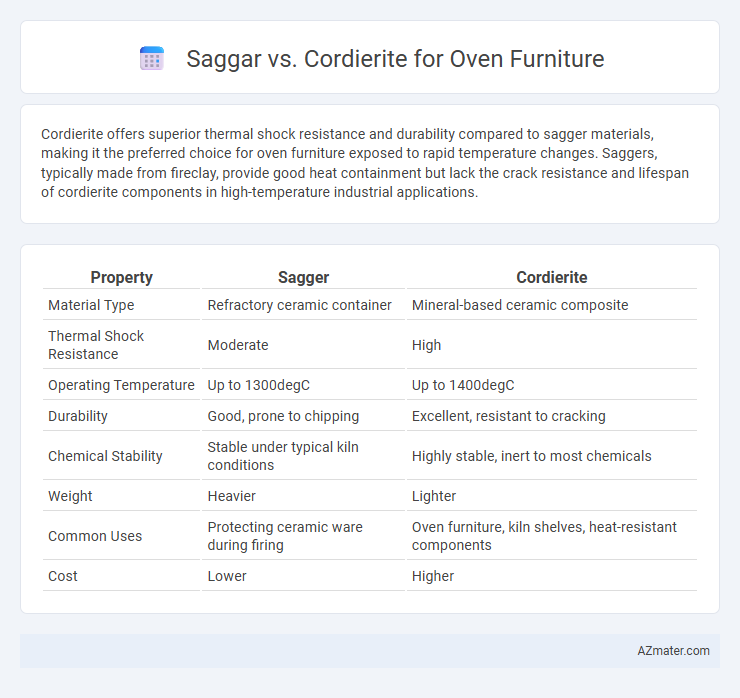Cordierite offers superior thermal shock resistance and durability compared to sagger materials, making it the preferred choice for oven furniture exposed to rapid temperature changes. Saggers, typically made from fireclay, provide good heat containment but lack the crack resistance and lifespan of cordierite components in high-temperature industrial applications.
Table of Comparison
| Property | Sagger | Cordierite |
|---|---|---|
| Material Type | Refractory ceramic container | Mineral-based ceramic composite |
| Thermal Shock Resistance | Moderate | High |
| Operating Temperature | Up to 1300degC | Up to 1400degC |
| Durability | Good, prone to chipping | Excellent, resistant to cracking |
| Chemical Stability | Stable under typical kiln conditions | Highly stable, inert to most chemicals |
| Weight | Heavier | Lighter |
| Common Uses | Protecting ceramic ware during firing | Oven furniture, kiln shelves, heat-resistant components |
| Cost | Lower | Higher |
Introduction to Oven Furniture Materials
Saggars and cordierite are essential materials in oven furniture, primarily used to enhance durability and thermal stability during high-temperature firing processes. Saggars, typically made from refractory clay, provide protective enclosures that shield ceramics from direct flame and contaminants, while cordierite is a mineral-based ceramic known for its excellent thermal shock resistance and low thermal expansion, making it ideal for kiln shelves and supports. Choosing between saggar and cordierite depends on factors like firing temperature, mechanical strength requirements, and thermal conductivity to optimize oven furniture performance.
What is Sagger?
Sagger is a protective container made from refractory clay or ceramic materials used in kiln firing to shield delicate ceramics from direct flame and ash contamination. It provides thermal insulation and ensures even heat distribution, preventing defects like warping or cracking in pottery. Unlike cordierite, which is a durable kiln shelf material, saggers specifically encapsulate items, enhancing the quality and finish of oven furniture during high-temperature firings.
Understanding Cordierite
Cordierite is a ceramic material known for its excellent thermal shock resistance and durability, making it ideal for oven furniture such as saggers and kiln shelves. Unlike traditional saggers made from fireclay, cordierite withstands rapid temperature changes without cracking, ensuring longer service life in high-heat applications like baking and ceramics firing. Its low thermal expansion coefficient and high strength contribute to improved performance and energy efficiency in industrial ovens.
Thermal Properties: Sagger vs Cordierite
Cordierite offers superior thermal shock resistance and stability compared to traditional sagger materials, making it ideal for repeated high-temperature cycles in oven furniture applications. The low thermal expansion coefficient of cordierite minimizes cracking and deformation under rapid temperature changes, ensuring longer shelf life and durability. In contrast, saggers made from less stable materials exhibit higher thermal conductivity but reduced resistance to thermal stress, leading to frequent replacement and increased operational costs.
Mechanical Strength Comparison
Cordierite exhibits superior mechanical strength compared to sagger materials, offering enhanced resistance to thermal shock and mechanical stress in oven furniture applications. Its crystalline structure allows for high durability and reduced fracture risk under repeated heating and cooling cycles, whereas sagger materials tend to be more brittle and less resistant to mechanical deformation. This strength difference makes cordierite the preferred choice for oven furniture requiring long-term mechanical stability and reliability.
Heat Shock Resistance
Cordierite exhibits superior heat shock resistance compared to sagger materials, making it ideal for oven furniture exposed to rapid temperature changes. While sagger remains useful for protecting ceramics during firing, its lower thermal shock tolerance limits durability under fluctuating heat conditions. Cordierite's ability to withstand abrupt temperature shifts without cracking significantly enhances oven furniture longevity and performance.
Chemical Durability
Cordierite exhibits superior chemical durability compared to sagger materials, making it highly resistant to thermal shock and chemical attack in oven furniture applications. Its low thermal expansion and chemical inertness prevent degradation from repeated heating and exposure to harsh kiln atmospheres. Sagger materials, typically composed of clay and refractory additives, are less chemically stable under prolonged exposure to fluxes and gases, leading to faster wear and contamination risks in high-temperature environments.
Cost and Lifespan Analysis
Cordierite ovens furniture offers superior thermal shock resistance and a lifespan that frequently surpasses 10 years, making it a cost-effective choice despite its higher initial price compared to sagger. Sagger materials, typically less expensive upfront, tend to have shorter durability under high-temperature cycles, often requiring replacement within 3 to 5 years, which can increase long-term expenses. Evaluating total cost of ownership, cordierite's extended lifespan and reduced maintenance needs often result in lower overall costs for commercial and high-usage ovens.
Best Applications for Sagger and Cordierite
Sagger is ideal for high-temperature kiln firing and protecting delicate ceramics by preventing direct flame contact and contamination, making it essential for porcelain and stoneware production. Cordierite excels in oven furniture applications requiring exceptional thermal shock resistance and dimensional stability, such as baking trays and kiln shelves in industrial and commercial ovens. Both materials are selected based on temperature range and structural durability, with Sagger preferred for protection during firing and Cordierite valued for long-term thermal performance in oven environments.
Choosing the Right Material for Your Oven Furniture
Choosing the right material for your oven furniture involves understanding the thermal properties and durability of Sagger and Cordierite. Sagger offers excellent heat resistance and is ideal for insulating and protecting ceramics during firing, while Cordierite provides superior thermal shock resistance and long-term durability, making it suitable for constant high-temperature use. Selecting Cordierite ensures improved oven longevity and performance, whereas Sagger is preferable for applications requiring protective liners in kiln shelves.

Infographic: Sagger vs Cordierite for Oven Furniture
 azmater.com
azmater.com